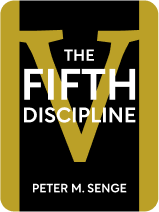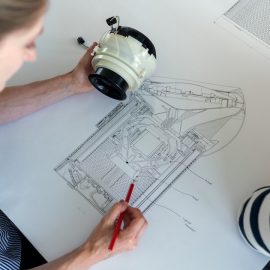

This article is an excerpt from the Shortform book guide to "The Fifth Discipline" by Peter M. Senge. Shortform has the world's best summaries and analyses of books you should be reading.
Like this article? Sign up for a free trial here.
What is Peter Senge’s The Fifth Discipline about? What is the key message to take away from the book?
Originally published in 1990, The Fifth Discipline is Peter Senge’s guide to creating a “learning organization.” A learning organization encourages its members to constantly develop their skills and to apply those skills to improve the organization.
Below is a brief overview of the key takeaways from Peter Senge’s The Fifth Discipline: The Art & Practice of the Learning Organization.
The Fifth Discipline: The Art & Practice of the Learning Organization
Senge is a systems scientist: someone who studies how various elements come together to form systems, and how those systems work and interact with each other. He holds an M.S. in social systems modeling and a Ph.D. in management, both from the Massachusetts Institute of Technology (MIT). The Fifth Discipline was his first book, and it remains his most famous work.
In The Fifth Discipline, Peter Senge discusses each of his five practices individually and concludes with the most important one: big-picture thinking, the titular Fifth Discipline. In this guide, we put that final practice first to help you understand what we’re working toward, then discuss the other four practices and how they each tie into that end goal.
Senge also puts numerous “rules” of big-picture thinking into a single chapter. We’ve broken up that chapter and put the rules in thematically appropriate places throughout the guide to more clearly connect principles with practices.
Our commentary will explain the science behind Senge’s key ideas, as well as draw connections to other influential business guides such as Skin in the Game, Principles: Life and Work, and Leading Change.
Discipline 5: Systems Thinking
Most people are taught to break problems apart when trying to solve them. This is because supposedly, it’s easier to learn about one thing at a time and then put the pieces together to see how the whole system works. However, Senge argues that life isn’t made of separate elements; rather, the world is made of countless different elements that come together to form systems. By trying to separate those elements from each other, you misrepresent how the world works and thus make it impossible to really understand what you’re observing.
This is one of Senge’s rules of big-picture thinking: Breaking up a system does not produce smaller versions of that system. For example, imagine trying to learn about cars by studying an engine—you might learn more about that one piece of the system, but you can’t extrapolate the rest of the car from it.
Senge says that businesses often suffer from a lack of big-picture thinking. Instead of operating as one big system—understanding that every part of the business will influence every other part—many companies try to operate as many individual units, with each person or group only paying attention to their own tasks. As a result, the different parts of the organization may interfere with each other without realizing it.
For example, an innovation allowing the company to ship more goods to a warehouse might seem beneficial, but it will put added strain on the warehouse employees and might lead to them quitting. Unless the company also ensures that the warehouse is prepared for the added workload, this apparently profitable innovation will hurt the company in the long run.
Think in Loops, Not Lines
Senge says that people naturally look for linear, cause-and-effect relationships because they’re clear and easy to understand. However, big-picture thinking relies on feedback loops. This means when you take an action, that action creates some effect; that effect eventually circles back around and influences the cause (you), often in an unexpected way.
Understanding and incorporating feedback is a crucial part of running an organization. Studying feedback is how you see the effects of your actions on the entire system, rather than just the part of it your decision directly altered.
One example of a feedback loop is an investment bubble: Investors overvalue a company or industry and invest heavily in it, which drives up its value. That causes others to overvalue it even more and invest even more, creating a loop of accelerating investment. However, this loop doesn’t last forever: Eventually, market forces catch up with the investment, the bubble bursts and the value plummets, and those investors unexpectedly lose a great deal of money.
Big-picture thinking could prevent you from being one of those unlucky investors—an accurate view of the market as a whole, rather than a narrow view of a single skyrocketing investment, could help you avoid bad investments or cash out before the bubble bursts.
The Results of Your Actions Take Time to Reveal Themselves
This brings us to another of Senge’s rules: What’s happening today is the result of what you did yesterday. He means that, quite often, you’ll have to wait to see the results of what you do. “Yesterday” isn’t literal—sometimes it takes weeks or months for the feedback to loop back around to you.
Be aware of that delay because otherwise, you might overreact: You take an action but don’t get the expected feedback right away, so you assume that whatever you did isn’t working. As a result, you either double down on your strategy or change your approach entirely. Then, by the time the feedback from the first action reaches you, you’ve already done something else, so you mistake it for the feedback from your second action. The cycle continues, and it usually results in you wildly swinging from one strategy to another.
In short, Senge urges you to be patient, be cautious, and not overreact to delays. Make sure you’ve got a sense of the big picture—including how long it might take for feedback to reach you—before responding to feedback or the lack of it.
It’s also important to realize that there are countless other systems at work in and around your organization. In fact, Senge says that we could view the whole world as a system made up of countless smaller systems, Therefore, a change you make to one part of your organization could have effects that stretch beyond the organization itself, and those effects could loop back around to your organization in ways that you didn’t foresee.
For example, when Ford started mass-producing cars, company executives probably didn’t realize that they’d be contributing heavily to global warming. However, as climate change became more of a concern, Ford (and other car manufacturers) were pressured to come up with more environmentally friendly vehicles and production methods.
The Two Kinds of Feedback
There are two types of feedback. The first type is called positive feedback—or, as Senge calls it, reinforcing feedback. This type of feedback naturally builds and intensifies, with each effect becoming the cause of the next event.
Positive feedback can either be good or bad for your company. You can be caught in a virtuous cycle where the feedback loop’s momentum pushes you toward your goals—however, you could also get caught in a vicious cycle, where the momentum works against you.
The other type of feedback is negative feedback, which Senge calls balancing feedback. Whereas positive feedback builds upon itself, this type of feedback moves toward a balance point where the cause-effect-cause cycle naturally stops. If that balance point is something beneficial for you or your company, this cycle is helpful and you should let it continue.
For example, some companies provide unlimited vacation days; this means that employees can take time off whenever they need to rest and come back to work when they’re ready. Ideally, this creates a balance point where each employee takes exactly enough vacation days to always work at his or her best. This negative feedback loop is beneficial to employers because the improved productivity at work more than makes up for the extra time off.
However, if the balance point is something undesirable, then you must take action to disrupt the feedback loop. Simply doubling down on your current strategy won’t work: Senge explains that however hard you push, the system will push back harder. In other words, you can’t force a system to do something it’s not designed to do—instead, you have to change how the system itself works.
For example, say you run a business and sales (the output) are lower than you’d like. Pouring more money (input) into an advertising campaign might bring in more customers for a short time, but unless your company is able to retain those customers, you’ll soon return to the same level of business you had before the extra advertising (your balance point). Breaking out of this negative feedback loop requires updating your entire company—your system—to both attract and retain new customers, rather than simply increasing the input of money.
Discipline 1: Constant Personal Growth
Now that we’ve explained Senge’s most important discipline, we’ll explore the other four disciplines and how they tie into big-picture thinking. The first discipline is constant personal improvement: what Senge calls personal mastery.
To create an evolving organization, the people within that organization must be willing to learn. Senge says that you should see your life as a never-ending learning process and make a commitment to constant growth and self-improvement.
Senge says that personal growth requires two things: clear goals to strive toward, and a creative mindset so you can find ways to reach those goals.
Dedication to constant improvement makes people feel more committed, happier, and more fulfilled in their work—remember, people are naturally driven to learn. However, many companies don’t encourage personal growth because they can’t easily measure its effectiveness. Instead, those companies expect employees to focus on their day-to-day tasks and to do them “by the book,” with no room for personal growth or new discoveries. In doing so, they stifle people’s potential and enthusiasm.
How Personal Growth Ties Into the Big Picture
Senge reminds us that, for all his talk about learning and evolving organizations, organizations don’t actually learn; people learn and then contribute their improved skills and knowledge to the organization. Therefore, when every part of your company—in other words, each individual person within it—is committed to growth and improvement, the organization as a whole will naturally grow and improve.
To incorporate personal improvement into your business, Senge suggests building the company culture around it from the ground up. In short, every member of your company, as well as the company’s policies, must support honesty, creativity, and challenging the status quo.
However, if you’re not in a position to do that, you can also try to start it as a grassroots movement within the organization: Practice personal growth yourself, regardless of whether or not the higher-ups encourage it, and try to get your coworkers to do the same. Hopefully, your supervisor will take note of your department’s improved performance and ask how you accomplished it. That will begin an organizational change from the bottom up, rather than from the top down.
Discipline 2: Constant Worldview Improvement
The second of Senge’s disciplines is to improve your ability to see the big picture by constantly assessing and updating what you think you know.
What Senge calls mental models are the closely-held beliefs and assumptions that make up your worldview. Your worldview affects how you interpret your experiences, and it therefore constantly influences your thoughts and behavior.
Senge adds that it’s impossible to have a completely correct worldview—all worldviews are subjective and simplified versions of the truth. That’s why he calls on us to constantly examine and improve our worldviews: to make them more correct, even though they’ll never be 100% correct.
Senge adds that people often have great ideas about how to improve themselves or their organizations but fail to implement those ideas because they contradict their secretly held beliefs. For example, a store manager might have an idea for a fun event to boost employee morale and customer engagement yet never bring it up because he or she assumes that executives will reject the idea. The manager could challenge this worldview by pitching the idea anyway and seeing if his or her beliefs hold true.
Strengthening an Organization’s Worldview
According to Senge, organizations have worldviews just like people do—after all, organizations are made up of people. Furthermore, just like individual worldviews, company worldviews can be examined, questioned, and improved.
Changing an organization’s worldview requires extreme openness and honesty from its members. Therefore, the company culture must encourage everyone to speak their minds, share what they’re really thinking, and help each other realize what biases and assumptions they’re each bringing to the table.
Senge also notes that not everyone has to agree on a single worldview—but, everyone has to work together to give people in charge the most accurate worldview possible. They do this by pointing out flaws in the current mental model, offering ideas and alternatives, and supporting the mental model that is ultimately chosen as the strongest. In other words, everyone agrees to go along with the final decision, even if they still have personal reservations about it.
To keep discussions productive, remember that the goal isn’t to “win” or to have your own plans and ideas chosen. Rather, the goal is to make sure that the company goes forward with the most accurate worldview possible.
Finally, Senge says that improving a worldview—whether your own or an organization’s—is a constant and ongoing process, just like personal growth. You’ll inevitably find flaws and mistaken beliefs with any worldview, so keep an open mind and continue making changes as needed.
How Worldview Improvement Ties Into the Big Picture
As your worldview becomes more accurate, you’ll gain a clearer picture of how individual elements come together to form systems, including how those parts influence each other and influence the system as a whole. This large-scale understanding is crucial because—as Senge explains—the line from cause to effect is often long and unclear. We’ve already discussed the time delay in receiving feedback; now Senge adds that changing one part of a system can affect distant, apparently unrelated parts of that system.
For example, imagine taking a painkiller when you have a headache: A pill goes into your stomach, and a little while later your head stops hurting. This doesn’t seem strange because you already know that all the parts of your body are an interconnected system. Senge is urging you to realize that a company functions much like a human body—making a change to one part of the organization could affect any or all of the other parts. Having a more accurate worldview will naturally improve your ability to see this big picture, and it’ll thus help you make effective and productive decisions.
Discipline 3: A Common Mission
A common mission—what Senge calls a shared vision—forms when people orient their personal objectives toward an overarching goal. In other words, an organization comes together and says, “This is the future we want,” and then each member of that organization does his or her best to realize that vision.
Having a common mission gives the organization the energy and perseverance to work toward its long-term goals. Organizations that don’t have a common mission, on the other hand, won’t work as hard because the employees don’t have that motivation.
That doesn’t mean everyone has exactly the same vision, or that they sacrifice their personal aspirations for the common mission. Rather, everyone’s personal motivations influence how they view the common mission: Each person will approach the common mission in a slightly different way based on their own experiences, duties, and worldview. In fact, when coming up with a common mission, Senge advises you to find out what’s most important to each of your employees and to try to work those goals into it.
For example, say a sneaker manufacturer creates a common mission that everybody in the country will have at least one good, solid pair of sneakers. A company survey then reveals that many employees have personal goals of caring for their families and improving the local community. The company might weave those missions together by offering employee discounts (helping them care for their families by giving them shoes) and organizing charity drives to give shoes to impoverished and homeless people (helping employees create positive changes in the community). In this way, a common mission bolsters the company as a whole and the employees as individuals.
How a Common Mission Ties Into the Big Picture
Your company’s common mission is your end goal; big-picture thinking helps you to create and refine that goal, as well as see how to get there. The variety in perspectives from employees all working toward the same goal will help the company as a whole to learn, grow, and find creative solutions to problems.
While your mission should be audacious and inspiring, the steps you take to reach it don’t have to be. Senge explains that you can get big results from small changes, but the most effective changes are often the least obvious ones:, You don’t necessarily need to make big changes, you just need to make the right changes. Of course, which changes are the right ones will depend on your organization and the market you’re operating in. Having a lot of different perspectives and ideas will help you to find and make those less-obvious changes; one person might find a solution that others have overlooked.
Discipline 4: Group Evolution
Group evolution—what Senge calls team learning—is the process by which a group of people learns how to work together effectively and help each other reach their shared goals. Senge says that group evolution has three key aspects:
1) Group-based worldview improvement. As we discussed previously, team members should work together to identify each other’s faulty assumptions and improve each others’ worldviews.
2) Spontaneous teamwork. A team that has learned to work together and evolve together will sometimes take actions that are unplanned, yet perfectly coordinated. Much like a trained and practiced troupe of improvisational actors, the team members understand and trust each other to the point that their teamwork becomes instinctual.
3) Connections with other teams. Remember that your team is just one part of a larger system, and whatever decisions you make will likely need other teams from other parts of the organization to put them into practice. Therefore, it will benefit your team (and the organization as a whole) to promote group evolution practices among those other teams as well.
Senge warns that group evolution is a difficult process, and it will take a lot of practice—figuring out how to work together effectively often means discovering all the ways that you don’t work together effectively. Personalities might clash, ideas may interfere with each other, and team members might find themselves stepping on each others’ toes when communication isn’t clear enough. That’s why Senge lays down the rule: Do not assign blame.
An evolving team—and an evolving organization—is bound to make mistakes along the way. In fact, that’s how evolution happens: People make mistakes or run into problems and then learn how to avoid them in the future. Just remember that you are a team, working together and learning together. So, instead of turning against each other to find someone to blame, turn your combined efforts against the problem.
How Group Evolution Ties Into the Big Picture
Senge asserts that group evolution is, in essence, organizational evolution on a smaller scale. It requires the same skills and practices as improving your organization’s worldview, and it’s how your team members help each other to accomplish the organization’s common mission.
Also, your team is part of the organization as a whole—so by helping your team to improve its worldview, develop teamwork, and spread those skills to other teams, you’re directly doing the work of creating an evolving organization.
Remember that an organization is nothing but the people who comprise it—once every team and every person in the organization is practicing personal growth and big-picture thinking, you will have created an evolving organization.

———End of Preview———
Like what you just read? Read the rest of the world's best book summary and analysis of Peter M. Senge's "The Fifth Discipline" at Shortform.
Here's what you'll find in our full The Fifth Discipline summary:
- Why an organization should encourage its members to constantly learn and develop their skills
- The five disciplines for creating an evolving organization
- Why you should constantly assess and update what you think you know






